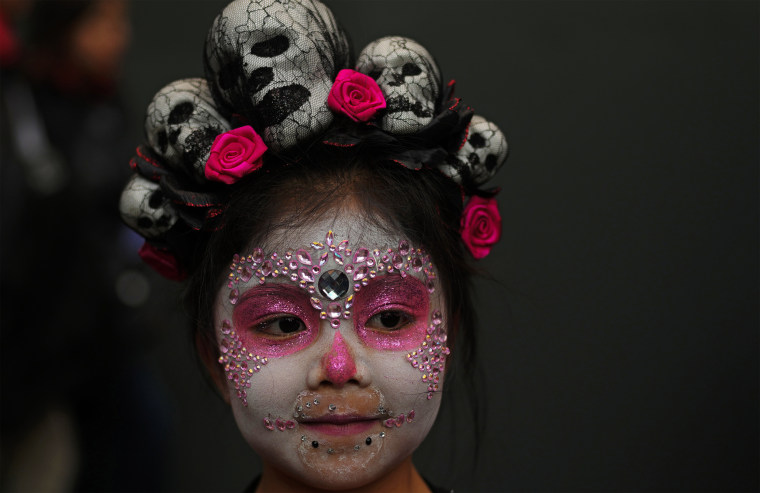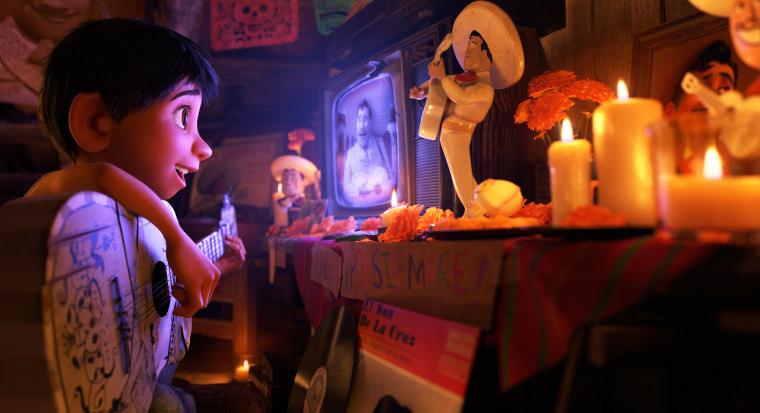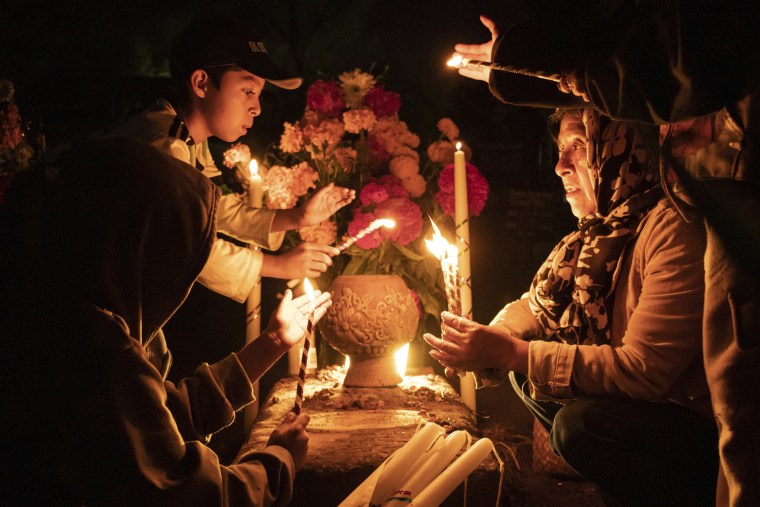Few topics are as complex for children to deal with as death.
But films like "Coco" by Disney Pixar have put death as the protagonist — and that has invited children and adults to approach it not with sadness or fear but as a tribute to life itself: If children ask what happens when someone dies, the message is that we remember them, because memory is life.
“We die physically but the memory will always be alive,” Regina Cantú, a thanatologist and emotional coach, said in an interview with Noticias Telemundo.
“The movie "Coco" leaves us with that teaching in general: how to approach this issue with children. It is taking advantage, in a good sense, of the topic of death. ... We’re not like video games, where characters come back. We are finite. When are we going to die? Nobody knows,” she added.
'A healthy way of seeing death'
Children take note of adults’ reactions to death. “If adults see death as something natural in life and transmit that to children, then there will not be so much fear or taboo on this topic,” explains Alicia Hinojosa, a psychologist who has a doctorate in thanatology.
For those who grow up celebrating the Día de los Muertos, or the Day of the Dead tradition which originated in Mexico, this holiday can offer an encouraging perspective on the loss of a loved one.
“For me, thinking about the Day of the Dead is like a celebration of life and the impact that those people had on us. It was always a very jovial celebration, very full of joy because we were doing something that we thought they (the deceased) would like. We feel like we are throwing a surprise party for those who beat us to it,” said Rossy Lima, a writer and doctor in linguistics at Texas A&M University-Corpus Christi.
It's a different way to approach a topic that, in most cultures, is primarily painful and sometimes macabre.

“I think that, culturally, it is a very different way of seeing death, but I think it is also a very healthy way of seeing death,” Adrian Molina, co-creator and co-writer of the film "Coco," said in an interview with Noticias Telemundo. “We have all lost someone and it has helped us make peace (with the loss) to think that they are still with us."
And for children who did not get to know important members of their families, the tradition of the altar of the dead is an opportunity to hear their stories and address concerns about death.
For more from NBC Latino, sign up for our weekly newsletter.
“The altar of the dead encourages these conversations and, as parents, we must be prepared to answer the children’s questions,” said Andrea Menchaca, a resident of Monterrey in northern Mexico, who usually dedicates the altar to her father, who died in 2003.
“By putting up my dad’s photo and things, it opens up a conversation about who he was since they didn’t know him,” she said referring to her children, 11 and 9 years old. “It also opens up the conversation about death: They want to know why he died, how he died and what I felt. You tell them that it hurts you a lot because you love the person a lot, but you also give thanks for everything you experienced."
A movie helped 'normalize' a family ritual
Lima, who is also a poet, said that celebrating the Day of the Dead helped her connect to her Mexican roots. However, when she was little, before the celebration became popular, some neighbors did not understand it. “Many were from northern Mexico and did not celebrate it. Others, also due to religious orientations, thought it was like witchcraft,” she said.
She said her mother, who's a seamstress, would put a sheet on top of the family's altar during Day of the Dead celebrations, but "I think the movie "Coco" helped a lot to normalize having an altar at home. It also helped because we struggled to find the components of the altar, things as specific as the Cempasúchil flower,” or marigolds that are part of Día de los Muertos celebrations.

After the death of her maternal grandfather in 2016, Lima said, the Day of the Dead celebration was significant since they couldn't attend the funeral. They looked for a great photo of him and chose to put a blue sail on his altar to remember his blue boat.
In the case of families who don't celebrate Día de los Muertos, the lives of those who died can also be celebrated through small moments, according to thanatologist Delia Salinas. “For example, at mealtime, if you make a soup that your grandpa really liked, it's a good opportunity to talk to the children about that family member."
After 'Coco,' a growing acceptance
Both Lima and Molina say that after the release of "Coco," they saw more acceptance of the Day of the Dead tradition.
“Before the movie, I think there were a lot of people who longed for that connection with their loved ones and maybe a connection with their culture,” Molina said. “We put a lot of effort into helping to invite the audience to understand the purpose of the tradition … to really show the vitality and the love of that practice and, yes, in some way normalize it or help people understand the meaning behind those symbols."
“We found that there was a really deep emotion that came up in people when they were able to sit with this idea of having permission to talk about the people they miss, having permission to tell stories,” he said.
Currently, numerous cities in the United States hold Día de los Muertos festivals and parades to celebrate Nov. 1 and 2. Cities such as Houston, San Antonio and Corpus Christi, in Texas, display altars and invite people to participate in the different celebrations. In Los Angeles, altars are set up with offerings and public spaces are decorated with Cempasúchil flowers and confetti.

Hollywood Forever Cemetery, for example, says it hosts California’s largest Day of the Dead celebration, covering the cemetery grounds with altars and art displays, accompanied by dance and musical performances.
Speak honestly
When talking about death, the first thing is to be honest, said Hinojosa, who is also president of the Elisabeth Kübler-Ross Mexico Foundation, which provides guidance around end-of-life issues.
“Many times, parents or people who take care of the children are afraid to bring up the subject and they think the children will be scared,” she said. “But they get more scared when they see that there are sad faces, that something is happening and they don’t know what ... if it is not made clear to them what is happening, then the mourning drags on for a long time.”
If the Day of the Dead or a movie like "Coco" puts the topic on the table, experts emphasize that it is important to talk with the little ones about what is happening, what the movie is showing, and explain to children that “death is universal, it is irreversible and it is no one’s fault," Hinojosa said.
Validate kids' feelings
When there is a loss in the family, Hinojosa said, it should be a close relative who explains the situation to the child. The expert also explained it's important to listen to the little ones and validate their feelings.
“If a child gets very angry, it is about hugging them and validating what they feel,” says the thanatologist. “It is telling the child: you are right, it also hurts me that your father is no longer with us, I miss him too, but we are going to move forward together, as a family, and I am going to take care of you.”
Hinojosa also alerts caregivers that children experience grief differently than adults .
“Adults are permanently sad and little by little they recover," she said. "Children’s grief is intermittent. Sometimes they feel sad and sometimes they feel good. Is not fixed”.
Taking the fear out of death
The skulls that are part of the Day of the Dead also bring an element of humor to a topic that, in most cultures, is somber. There are the sugar and chocolate skulls that children enjoy and the “literary skulls,” small satirical poems that joke about the ways in which death could take someone. They normally refer to the personality of the person they refer to and their tastes.
A common activity in Mexican schools in the weeks before the Day of the Dead is to write literary skulls. Teachers can ask students to write one about a classmate and newspapers usually publish their own skulls about politicians or artists. There are also local and national literary skull contests.
“To write the skull, you have to have a creativity that has to be like the fine line between tender and gloomy,” Lima said.
A previous version of this story was first published in Noticias Telemundo.
